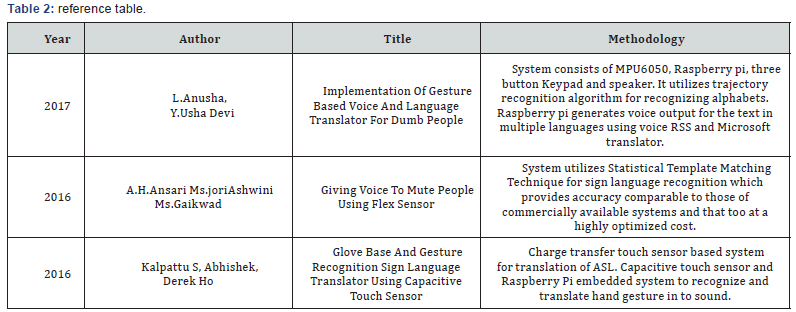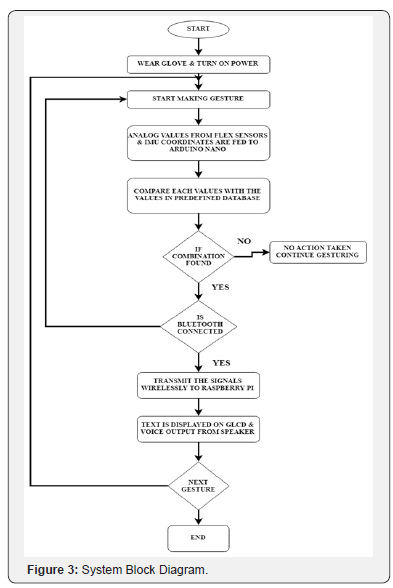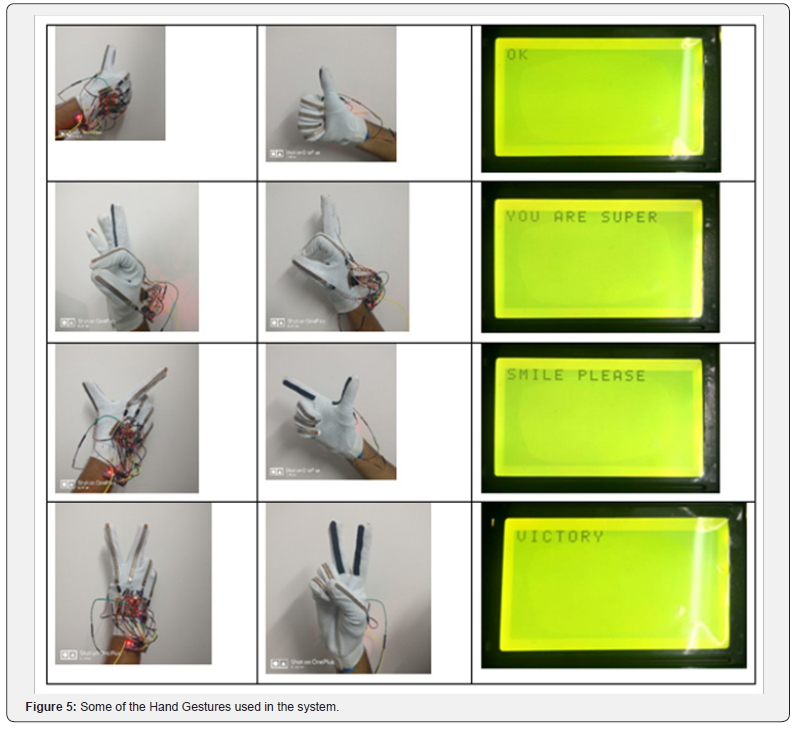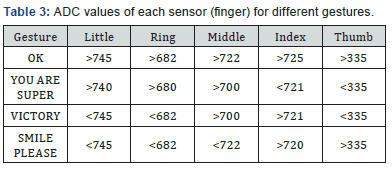Wireless Glove for Hand Gesture Acknowledgment: Sign Language to Discourse Change Framework in Territorial Dialect- Juniper Publishers
Juniper Publishers- Journal of Robotics
Abstract
Generally deaf-dumb people use sign language for
communication, but they find it difficult to communicate in a society
where most of the people do not understand sign language. Due to which
communications between deaf-mute and a normal person have always been a
challenging task. The idea proposed in this paper is a digital wireless
glove which can convert sign language to text and speech output. The
glove is embedded with flex sensors and a 9DOF inertial measurement unit
(IMU) to recognize the gesture. A 9-degree of freedom inertial
measurement unit (IMU) and flex sensors are used to track the
orientation of fingers and motion of hand in three dimensional spaces
which senses the gestures of a person in the form of bend of fingers and
tilt of the hand fist. This system was tried for its practicality in
changing over gesture based communication and gives the continuous
discourse yield in local dialect and additionally shows the text on GLCD
module. The text show being in English, the voice yield of the glove
will be in provincial dialect (here Kannada). So this glove goes about
as a communicator which in part encourages them to get their necessities
and an interpreter giving greater adaptability in correspondence. In
spite of the fact that the glove is planned for gesture based
communication to discourse transformation, it is a multipurpose glove
and discovers its applications in gaming, mechanical autonomy and
therapeutic field.In this paper, we propose an approach to avoid the gap
between customer and software robotics development. We define a EUD
(End-User Development) environment based on the visual programming
environment Scratch, which has already proven in children learning
computer science. We explain the interests of the environment and show
two examples based on the Lego Mindstorms and on the Robosoft Kompai
robot.
Keywords: Sign Language; Flex Sensors; State Estimation Method; 3D Space; Gesture Recognition
Abbrevations:
ANN: Artificial Neural Networks; SAD: Sum of Absolute Difference; IMU:
Inertial Measurement Unit; ADC: Analog to Digital Converter; HCI: Human
Computer Interface
Introduction
About nine thousand million people in the world are
deaf and mute. How commonly we come across these people communicating
with the normal world? The communication between a deaf and general
public is to be a thoughtful issue compared to communication between
visually impaired and general public. This creates a very small space
for them as communication being a fundamental aspect of our life. The
blind people can talk freely by means of normal language whereas the
deaf-mute people have their own manual-visual language popularly known
as sign language [1]. The development of the most popular devices for
hand movement acquisition, glove-based systems started about 30 years
ago and continues to engage a growing number of researchers. Sign
language is the non-verbal form of intercommunication used by deaf and
mute people that uses gestures instead of sound to
convey or to express fluidly a speaker’s thoughts. A gesture in a sign
language is a particular movement of the hands with a specific shape
made out of them [2]. The conventional idea for gesture recognition is
to use a camera based system to track the hand gestures. The camera
based system is comparatively less user friendly as it would be
difficult to carry around.
The main aim of this paper is to discuss the novel
concept of glove based system that efficiently translates Sign Language
gestures to auditory voice as well as text and also promises to be
portable [3]. Several languages are being spoken all around the world
and even the sign language varies from region to region, so this system
aims to give the voice output in regional languages (here Kannada). For
Sign language recognition few attempts have been made in the past to
recognize the gestures using camera, Leaf switches and copper plates but
there
were certain limitations of time and recognition rate which
restricted the glove to be portable. Mainly there were two
well-known approaches viz. Image processing technique and
another is processor and sensor based data glove [4]. These
approaches are also known as vision based and sensor based
techniques. Our system is also one such sensor based effort to
overcome this communication barrier, which senses the hand
movement through flex sensors and inertial measurement
unit and then transmits the data wirelessly to the raspberry
pi which is the main processor, that accepts digital data as
input and processes it according to instructions stored in its
memory, and outputs the results as text on GLCD display and
a voice output.
Background Work
People who are hard of hearing or quiet are isolated in
the cutting edge work environment as well as in regular daily
existence making them live in their own different networks.
For example, there have been enhancements in amplifiers and
cochlear inserts for the hard of hearing and counterfeit voice
boxes for the quiet with vocal rope harm. Be that as it may, these
arrangements don’t come without drawbacks and expenses [5].
Cochlear inserts have even caused a tremendous debate in the
hard of hearing network and numerous decline to considerably
think about such arrangements. Thusly, we trust society still
requires a compelling answer for expel the correspondence
obstruction between hard of hearing and quiet people and nonmarking
individuals. Our proposed arrangement and objective
is to plan a Human Computer Interface (HCI) gadget that can
make an interpretation of gesture based communication to
content and discourse in provincial dialect, furnishing any
hard of hearing and quiet people with the capacity to easily
speak with anybody [6]. The thought is to plan a gadget put
on a hand with sensors fit for assessing hand signals and after
that transmitting the data to a preparing unit which plays out
the communication via gestures interpretation. The last item
will have the capacity to proficiently perform gesture based
communication and give the focused on yield. We want to have
the capacity to enhance the personal satisfaction of hard of
hearing and quiet people with this gadget.
Comparison of Background Related Work
(Table 1)

Problem Definition
With a population of around 7.6 billion today communication
is a strong means for understanding each other. Around nine
thousand million individuals are deaf and mute. Individuals
with discourse hindrance their vocal articulation are not
reasonable, they require a specific skill like static state of the
hand orientation to give a sign, more as manual-visual dialect
prevalently known as sign language to communicate with
general population. They think that it’s hard to impart in a
general public where a large portion of the general population
don’t comprehend sign language. Hence forth they find a little
space to convey and do not have the capacity to impart at a
more extensive territory [7].
Literature Survey
The system investigates the utilization of a glove to give
communication via gestures interpretation in a way that
enhances the techniques for previous plans. Few university
research has taken an activity to make prototype devices
as a proposed answer for this issue, these devices focus on
reading and analyzing hand movement. However, they are
lacking in their capacity to join the full scope of movement
that gesture based communication requires, including
wrist revolution and complex arm developments (Table 2).

Proposed System
(Figure 1)

Block Diagram Explanation
The sensor based system is designed using four 4.5 inch
and two 2.2-inch flex sensors which are used to measure the
degree to which the fingers are bent. These are sensed in
terms of resistance values which is maximum for minimum
bend radius. The flex sensor incorporates a potential divider
network which is employed to line the output voltage across 2
resistors connected as shown in Figure 2.

The output voltage is determined using the following
equation,

Where;
R1 - flex sensor resistance. R2 - Input resistance.
The external resistor and flex forms a potential divider that
divides the input voltage by a quantitative relation determined
by the variable and attached resistors. For particular gestures
the current will change, as a result of the changing resistance
of the flex sensor which is accommodated as analog data.
One terminal of flex sensor is connected to the 3.3Volts and
another terminal to the ground to close the circuit. A 9-Degree
of Freedom Ardu Inertial Measurement Unit (IMU) is essential
for accelerometer and gyroscope readings which is placed on
the top of the hand to determine hand position. The co-related
3D coordinates are collected by the inertial measurement
unit as input data [8]. The impedance values from flex sensors
and IMU coordinates for individual gesture are recorded
to enumerate the database. The database contains values
assigned for different finger movements. When the data is
fed from both flex sensors and IMU to Arduino nano it will be
compute and compare with the predefined dataset to detect
the precise gesture and transmitted wirelessly to the central
processor i.e. raspberry pi via Bluetooth module. Raspberry Pi
3 is programed to display text output on GLCD. Graphic LCD
is interfaced with the Raspberry pi3 using 20-bit universal
serial bus in order to avoid bread board connection between
processor and the display, and a 10Kohm trim potentiometer
is used to control the brightness of display unit. Further to
provide an auditory speech, pre-embedded regional language
voice is assigned for each conditions as similar to the text
database which is mapped with the impedance values. Two
speakers are used with single jack of 3.5mm for connection
and a USB to power-up the speakers [9]. When text is displayed,
the processor will search for the voice signal which will be
transmitted through speakers.
Methodology (Figure 3)
a) The gesture is served as an input to the system which
is measured by both the sensors particularly from the f lex
sensor in terms of impedance and the IMU gives the digital
values.
b) These values from the flex sensor are analog in nature
and is given to the Arduino nano which uses the analog to
digital convertor consolidated in it to convert the resistive
values to digital values.
c) IMU utilizes the accelerometer/gyroscope sensors to
measure the displacement and position of the hand.
d) These qualities from both the sensors are fed to
Arduino nano which contrasts it and the values stored
in the predefined database, and further transmits this
digital data wirelessly to the main processor by means of
Bluetooth.
e) Central processor the raspberry pi3 is coded in
python dialect for processing the received digital signals
to generate the text output, for example, characters,
numbers and pictures. Further, the text output is shown on
Graphic-LCD display and next text to speech engine, here
particularly espeak converter is utilized to give the soundrelated
voice output [10].
Finally, system effectively delivers the output as text and
auditory voice in regional dialect.

Prototype Implementation and its Working
In this system, the features are extracted from the hardware
sensor inputs and the targets are the words in sign language. To
realize the design requirements, several hardware components
were considered during prototyping. Much of the hardware
was selected due to their ease of use and accuracy. The Ardu
9DOF IMU was selected for convenience as it produces the
computation necessary for linear acceleration and gyroscopic measurements. The roll, pitch and yaw measurements were
found to be roughly ±2° accuracy which is far beyond sufficient
for our sign language requirements. Since the flex sensor
required additional analog pins, careful planning allowed us
to fit the circuit in an agreeable manner on the hand glove.
Space was managed to add in the HC05
Bluetooth module onto
the device. All the sensors must be placed in a way as to not
make contact with each other causing short circuits which and
disruption of measurement readings [11]. Electrical tape was
necessary to provide insulation for our sensors. The system
recognizes gestures made by the hand movements by wearing
the glove on which two sensors are attached, the first sensor is
to sense the bending of five fingers, the flex sensor of 2.2 inches
for thumb and for the other four fingers of 4.5 inches and the
second sensor used is 9-DOF Inertial Measurement Unit to
track the motion of hand in the three-dimensional space,
which allows us to track its movement in any random direction
by using the angular coordinates of IMU (pitch, roll and yaw).
Since the output of f lex sensor is resistive in nature the values
are converted to voltage using a voltage divider circuit.
The resistance values of 4.5-inch flex sensors range from
7K to 15K and for 2.2-inch flex sensor, it ranges from 20K to
40K, as shorter the radius the more resistor value. Another
2.5K ohm resistor is utilized to build a voltage divider circuit
with Vcc supply being 3.3volts taken from Arduino nano
processor, the voltage values from the voltage divider circuit
being analog in nature are given to the Arduino nano processor
which has an inbuilt ADC [12]. Further, the IMU senses the hand
movements and gives the digital values in XYZ direction called
the roll, yaw, pitch respectively. The values from the IMU and
values of the flex sensors are processed in the Arduino nano
which is interfaced with HC-05 Bluetooth module embedded on
the glove which provides the approximate range of 10 meters.
The data processed in nano are sent wirelessly through
Bluetooth to the central processor i.e. Raspberry Pi which is
coded in python, in a way to convert given values into the text
signal by searching in database for that particular gesture.
In accordance with the digital value received, the impedance
values along with 3 dimensional IMU coordinates for each
individual gestures are recorded to enumerate the database.
The database contains collective resistance values assigned
for different finger movements. When the computed data is
received by the processor, it is compared with the measured
dataset to detect the precise gestures. If the values matches,
then the processor sends the designated SPI commands to
display the texts according to gestures onto the GLCD and the
espeak provides the text to speech facility giving audible voice
output in regional language through the speakers. Further,
for any next gestures made, both flex sensor and IMU detects
and data is compared with the database already present in
the processor and if it matches, displays in text format as well
as audible output speech will be given by the speakers [13]
(Figure 4).

Results
In this prototype system, the user forms a gesture and
holds it approximately for 1 or 1.5 seconds to ensure proper
recognition. Each gesture comprises of bending of all fingers
in certain angles accordingly. Every bend of the sensor (finger)
produces unique ADC value so that when different hand
gesture is made, different ADC values are produced. Taking
such ADC values for 4 different users, a table of average ADC
values for each sensor is maintained where F1, F2, F3, F4 and
F5 represents the little finger, the ring finger, the middle finger,
the index finger and thumb respectively. Table 3 shows the
gestures and corresponding words voiced out. The hand signs
taken in the prototype can be easily modified using the concept
of ADC count according to the user convenience. At the same
time the voice output can be changed easily to gives a flexibility
in change of language according to different regions (Figure 5).


Applications
a) Voice interpreter for mute people
b) No touch user interface
c) Gaming industry: Hand gestures play a vital role in
the gaming industry, especially in first person shooting
games. The player can control the character in the game
using his hand and this could give a real life experience
of the game. Also, virtual reality is gaining grounds in the
gaming industry. Combining virtual reality with the gloves
with a haptic feedback can give the gamer a real life gaming
experience.
d) Controlling a robotic arm using the gloves: The gloves
could be used to control a robotic arm. The applications
for this system are wide. With incorporation of haptic
feedback, the glove -robotic arm interface could also be
used in bomb diffusion.
e) Remote medical surgery: In this the surgeon need not
be at the physical location to perform the surgery. He could
control a robotic arm remotely to perform the surgery and a haptic feedback could give him the feel of actually
performing the surgery. But this would require the gesture
recognition to be very precise and the transfer of data from
the hand to the robotic arm should be without even a tiny
glitch.
Advantages
a) Cost effective light weight and portable
b) Real time translation approximately in no time delay
c) Flexible for ‘N’ users with easy operation
d) Fully automate system for mute communication
Future scope
a) The system can be further developed with Wi-Fi
connection and enlarged database supporting special
characters or symbols.
b) Microsoft Text To Speech (TTS) engine can be
utilized to provide compatibility for multiple international
languages.
c) An Android application can be developed for
displaying the text and speech output on an Android device.
Conclusion
As we discovered that Deaf-quiet individuals utilize
communication via gestures to cooperate with others however
numerous don’t comprehend this motion dialect. We have
built up a sensor based motion acknowledgment framework
to undercover signal into local dialect discourse and content
yield. In this framework the hard of hearing quiet individuals
wear the gloves to perform hand motion, the transformation
of content to discourse in provincial dialect and show has
been seen to be predictable and dependable. In this way, the
proposed framework with the database of 20 words and 15
sentences has been effectively created which changes over the
motions into English words or sentences and shows the yield
on GLCD and relating voice yield in provincial dialects using
espeak. The proposed framework has insignificant equipment
mounted on it which makes it dependable, convenient and
savvy and more straightforward to speak with the general
public [14]. One more requesting where this framework
could be utilized as a part without bounds: Helping hand
for individuals with Cerebral Palsy; Cerebral palsy usually
appears in early childhood and involves a group of permanent
movement disorders. The symptom varies with people and
often includes poor coordination, stiff muscles, weak muscles,
and tremors. Also, the problems with sensation, vision, and
hearing, swallowing and speaking have been identified as
other symptoms [15,16]. This problem can be solved to a great
extent by providing them with a provision to communicate
with just a single finger. The frequently used words by such
people can be put across to people with just a small movement
in the finger and using our state estimation technique it could
predict the letters or words [17].
For More Open Access Journals Please Click on: Juniper Publishers
Fore More Articles Please Visit: Robotics & Automation Engineering Journal


Comments
Post a Comment